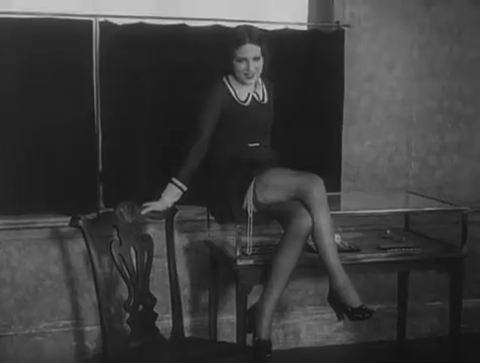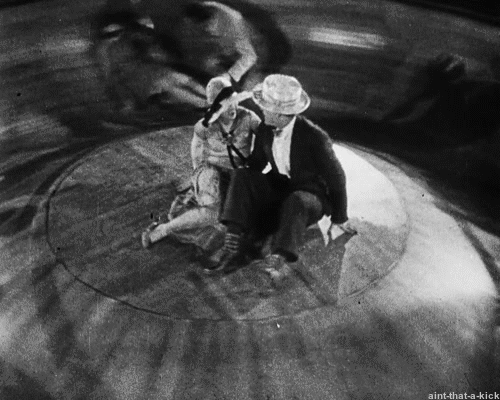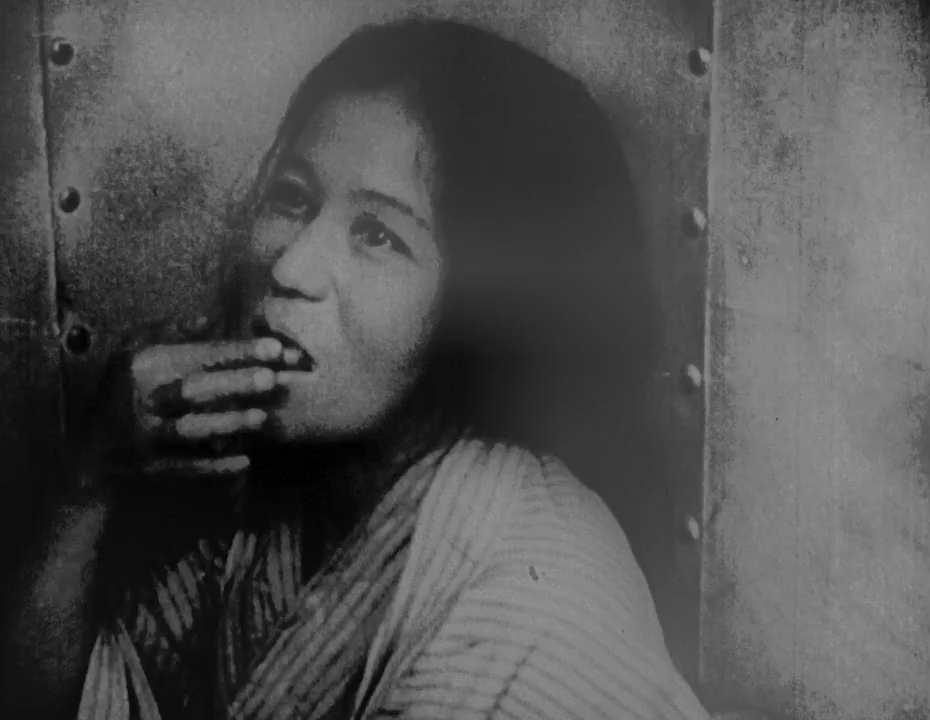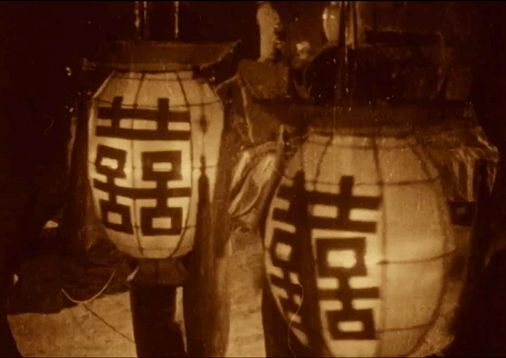La perle [The Pearl] (Henri d'Ursel, 1929)
Dec
15
National Wear Your Pearls Day

A giddy Kissa Kouprine as the jewellery salesgirl. A pearl necklace jauntily dangles from her suspender. DP: Marc Bujard.
Pearls worn for National Wear Your Pearls Day (USA). No one said those pearls were to be worn in the obvious place.
1920s
“Men! The beasts! God would show wisdom if he took the hands from all of them!” The Unknown (Tod Browning, 1927)
Dec
3
Let's Hug Day

Target girl Nanon (Joan Crawford) hugs her circus partner, Alonzo (Lon Chaney) the knife thrower. Her tight embrace may reveal his secret. DP: Merritt B. Gerstad.
Someone's hugged on Lets Hug Day (USA)
Nanon Zanzi (Joan Crawford) is mortally afraid of men. Of their grabbing, grasping, groping hands. This is why she only trusts her knife throwing partner Alonzo the Armless (Lon Chaney). What she doesn't know is that Alonzo and his 4'10”/1,47 m accomplice Cojo (that great staple of precode horror Tufei Filhela aka John George), use the #circus to hide from the long arm of the law, who is looking for a murderer with a deformed thumb. Who would suspect an armless man?
– Nanon Zanzi
As mighty as Alonzo may be, the incomparable Lon Chaney owes much to armless violinist and knife thrower “Judge” Paul Desmuke. Story goes that Desmuke taught Chaney his knife act in two months. More probable is that some of the more impressive close-up scenes show the Judge's, not Chaney's, feet.
Like Alonzo, The Unknown has lost some flesh. Until 1968, only mangled bootlegs were available; a complete print was considered non-existent. Five years later, news broke about film reels of unknown origin labelled inconnu – [the] unknown, somewhere in the bowels of the Cinémathèque Française.
Some 14 minutes, outlining the Armless' background, are still missing. Do check your attic.
– Nice day, isn't it?
– Yes, isn't it!
– It's swell. It's perfect.Lonesome (Pál Fejős, 1928)
Nov
20
A Beautiful Day

Our lovebirds holding out on the Human Roulette, one of the many dizzying Steeplechase attractions of Coney Island. DP: Gilbert Warrenton.
A beautiful day for Beautiful Day (USA??).
Two hopelessly lonely hearts meet each other at Coney Island, spending the most wonderful day in each other's company. Pál Fejős' joyful Lonesome was made just when motion pictures became talkies, and new and more modern novelties were expected by the audience. Fejős delivers, with sound and musical inserts, and the occasional – almost shocking – burst of colour.
With light touches of Murnau's groundbreaking Sunrise: A Song of Two Humans (1927) and Jean Vigo's more experimental À propos de Nice (1930), Lonesome depicts the exuberance of youth with an optimism soon to be lost to the vices of history.
Maciste all'inferno [Maciste in Hell] (Guido Brignone, 1925)
Oct
17
sinners

A demon eating a poor sinner. Numerous scenes are directly taken from Gustave Doré's illustrations of Dante's Divina Commedia, chapter Inferno. DPs: Ubaldo Arata, Massimo Terzano & Segundo de Chomón.
Медвежья свадьба [Medvezhya svadba / The Bear's Wedding] (Konstantin Eggert + Vladimir Gardin, 1925)
Sep
28

In preparation of the bear's wedding, a cook – wearing not much more than an apron and a toque blanche – stirs a huge kettle over a roaring fire. DPs: Eduard Tisse & Pyotr Yermolov.
Orlacs Hände [Die unheimlichen Hände des Doktor Orlac / The Hands of Orlac] (Robert Wiene, 1924)
Sep
25

Paul Orlac (Conrad Veidt) stretched out on a wooden bench in a tavern. A strange man sits on a second bench on the other side of the table. DPs: Hans Androschin & Günther Krampf.
狂つた一頁 [Kurutta ippēji / A Page of Madness] (Teinosuke Kinugasa, 1926)
Sep
12

The servant's wife (Yoshie Nakagawa) eating. She looks up at someone offscreen, and smiles. DP: Kōhei Sugiyama.
“You and I may dream of gold or grocery bills — but when a child slaps Morpheus on the back and says 'Hello, old man' — well it's a different story.”Moonland (William A. O'Connor, 1926)
Aug
15
Chant At The Moon Day

Mickey (Mickey McBan) and his dog looking up to the crescent moon from a perfectly round window with beaded curtains made of stars. Spot the Milky Way! DP: Edward Gheller.
A little boy and his dog are invited over by the Man in the Moon himself. The trip to the Moon is a big adventure for the drowsy duo and they meet peculiar flora, fauna and men along the way, lifted straight from the Great Moon Hoax.
– opening title card
Post-McCay's serial Little Nemo in Slumberland (1905) and pre-Fleming & Cukor's The Wizard of Oz (1939), William A. O'Connor is heavily indebted to both. Which doesn't make his short Art Deco-styled science fiction fantasy any less magical.
“Now I may die content, for I have seen great love.”Michael [Mikaël / Chained: The Story of the Third Sex / Heart's Desire] (Carl Theodor Dreyer, 1924)
Aug
3
National Michael Day

Art critic Switt (Robert Garrison) with muse Michael (Walter Slezak). DPs: Karl Freund & Rudolph Maté.
Considered one of the earliest positive cinematic depictions of (male) homosexuality, Carl Theodor Dreyer's Michael tells the story of lonely artist Zoret (director Benjamin Christensen), his bright young muse and model Michael (Walter Slezak), and the more mature art critic Switt (Robert Garrison). Though it's mostly suggested – there's a female temptress (Nora Gregor) assuming a heterosexual perspective – its motif of the spoken and unspoken relationship between the men is definitely one of love, much in the same way Charles Vidor's Gilda (1946) is.
– opening title card
Michael is the second book adaption of Herman Bang's Mikaël (1902) after Vingarne [The Wings] (Mauritz Stiller, 1916).
“Today is our Queen's wedding day, let us drink it up!”盘丝洞 [Pan si dong / The Cave of the Silken Web] (Dan Duyu, 1927)
Jul
14
Pandemonium Day

Pandemonium happening, with Tang Sanzang as its object of desire (gif via. DP: Ganting Dan.
Dan Duyu's 盘丝洞 is, in its most literal sense, a fantastic silent interpretation of Wu Cheng'en's 西遊記 / Journey to the West. Monk Tang Sanzang (Meikang Jiang) finds himself trapped in a cave with seven beautiful sisters. Two of Tang Sanzang's faithful disciples, Sun Wukong (the Monkey King) and Zhu Bajie (Pigsy: half man, half pig), need to save him before one of the sisters takes the celibate monk as her husband. What follows is a vigorous display of #wuxia, horror, monkey shenanigans, and – during the pandemonium unfolding in the final act – a small glimpse into the vast pantheon of China's gods and demons.
Note that some of the reels are still missing, and the English translation I found is subjective at best, so have a translation app at the ready. Nevertheless, take a moment to dim the lights, and accompany Tang Sanzang, the Monkey King, and Pigsy on their pilgrimage. Even if only for a little while.